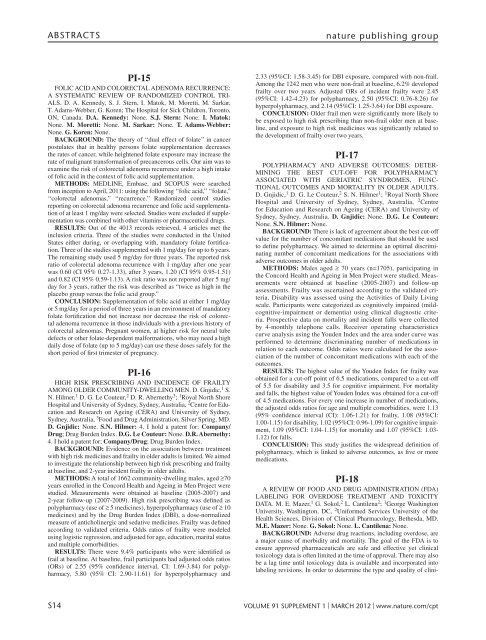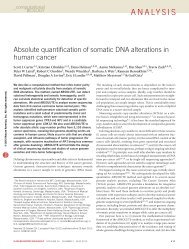Poster Session I (PI 1-106)Displayed 8:00 am – 3:00 ... - Nature
Poster Session I (PI 1-106)Displayed 8:00 am – 3:00 ... - Nature
Poster Session I (PI 1-106)Displayed 8:00 am – 3:00 ... - Nature
You also want an ePaper? Increase the reach of your titles
YUMPU automatically turns print PDFs into web optimized ePapers that Google loves.
aBsTraCTs nature publishing group<br />
<strong>PI</strong>-15<br />
FOLIC ACID AND COLORECTAL ADENOMA RECURRENCE:<br />
A SYSTEMATIC REVIEW OF RANDOMIZED CONTROL TRI-<br />
ALS. D. A. Kennedy, S. J. Stern, I. Matok, M. Moretti, M. Sarkar,<br />
T. Ad<strong>am</strong>s-Webber, G. Koren; The Hospital for Sick Children, Toronto,<br />
ON, Canada. D.A. Kennedy: None. S.J. Stern: None. I. Matok:<br />
None. M. Moretti: None. M. Sarkar: None. T. Ad<strong>am</strong>s-Webber:<br />
None. G. Koren: None.<br />
BACKGROUND: The theory of ‘‘dual effect of folate’’ in cancer<br />
postulates that in healthy persons folate supplementation decreases<br />
the rates of cancer, while heightened folate exposure may increase the<br />
rate of malignant transformation of precancerous cells. Our aim was to<br />
ex<strong>am</strong>ine the risk of colorectal adenoma recurrence under a high intake<br />
of folic acid in the context of folic acid supplementation.<br />
METHODS: MEDLINE, Embase, and SCOPUS were searched<br />
from inception to April, 2011: using the following ‘‘folic acid,’’ ‘‘folate,”<br />
‘‘colorectal adenomas,’’ ‘‘recurrence.’’ Randomized control studies<br />
reporting on colorectal adenoma recurrence and folic acid supplementation<br />
of at least 1 mg/day were selected. Studies were excluded if supplementation<br />
was combined with other vit<strong>am</strong>ins or pharmaceutical drugs.<br />
RESULTS: Out of the 4013 records retrieved, 4 articles met the<br />
inclusion criteria. Three of the studies were conducted in the United<br />
States either during, or overlapping with, mandatory folate fortification.<br />
Three of the studies supplemented with 1 mg/day for up to 6 years.<br />
The remaining study used 5 mg/day for three years. The reported risk<br />
ratio of colorectal adenoma recurrence with 1 mg/day after one year<br />
was 0.60 (CI 95% 0.27-1.33), after 3 years, 1.20 (CI 95% 0.95-1.51)<br />
and 0.82 (CI 95% 0.59-1.13). A risk ratio was not reported after 5 mg/<br />
day for 3 years, rather the risk was described as “twice as high in the<br />
placebo group versus the folic acid group.”<br />
CONCLUSION: Supplementation of folic acid at either 1 mg/day<br />
or 5 mg/day for a period of three years in an environment of mandatory<br />
folate fortification did not increase nor decrease the risk of colorectal<br />
adenoma recurrence in those individuals with a previous history of<br />
colorectal adenomas. Pregnant women, at higher risk for neural tube<br />
defects or other folate-dependent malformations, who may need a high<br />
daily dose of folate (up to 5 mg/day) can use these doses safely for the<br />
short period of first trimester of pregnancy.<br />
<strong>PI</strong>-16<br />
HIGH RISK PRESCRIBING AND INCIDENCE OF FRAILTY<br />
AMONG OLDER COMMUNITY-DWELLING MEN. D. Gnjidic, 1 S.<br />
N. Hilmer, 1 D. G. Le Couteur, 2 D. R. Abernethy 3 ; 1 Royal North Shore<br />
Hospital and University of Sydney, Sydney, Australia, 2 Centre for Education<br />
and Research on Ageing (CERA) and University of Sydney,<br />
Sydney, Australia, 3 Food and Drug Administration, Silver Spring, MD.<br />
D. Gnjidic: None. S.N. Hilmer: 4. I hold a patent for; Company/<br />
Drug; Drug Burden Index. D.G. Le Couteur: None. D.R. Abernethy:<br />
4. I hold a patent for; Company/Drug; Drug Burden Index.<br />
BACKGROUND: Evidence on the association between treatment<br />
with high risk medicines and frailty in older adults is limited. We aimed<br />
to investigate the relationship between high risk prescribing and frailty<br />
at baseline, and 2-year incident frailty in older adults.<br />
METHODS: A total of 1662 community-dwelling males, aged ≥70<br />
years enrolled in the Concord Health and Ageing in Men Project were<br />
studied. Measurements were obtained at baseline (2<strong>00</strong>5-2<strong>00</strong>7) and<br />
2-year follow-up (2<strong>00</strong>7-2<strong>00</strong>9). High risk prescribing was defined as<br />
polypharmacy (use of ≥ 5 medicines), hyperpolypharmacy (use of ≥ 10<br />
medicines) and by the Drug Burden Index (DBI), a dose-normalized<br />
measure of anticholinergic and sedative medicines. Frailty was defined<br />
according to validated criteria. Odds ratios of frailty were modeled<br />
using logistic regression, and adjusted for age, education, marital status<br />
and multiple comorbidities.<br />
RESULTS: There were 9.4% participants who were identified as<br />
frail at baseline. At baseline, frail participants had adjusted odds ratios<br />
(ORs) of 2.55 (95% confidence interval, CI: 1.69-3.84) for polypharmacy,<br />
5.80 (95% CI: 2.90-11.61) for hyperpolypharmacy and<br />
2.33 (95%CI: 1.58-3.45) for DBI exposure, compared with non-frail.<br />
Among the 1242 men who were non-frail at baseline, 6.2% developed<br />
frailty over two years. Adjusted ORs of incident frailty were 2.45<br />
(95%CI: 1.42-4.23) for polypharmacy, 2.50 (95%CI: 0.76-8.26) for<br />
hyperpolypharmacy, and 2.14 (95%CI: 1.25-3.64) for DBI exposure.<br />
CONCLUSION: Older frail men were significantly more likely to<br />
be exposed to high risk prescribing than non-frail older men at baseline,<br />
and exposure to high risk medicines was significantly related to<br />
the development of frailty over two years.<br />
<strong>PI</strong>-17<br />
POLYPHARMACY AND ADVERSE OUTCOMES: DETER-<br />
MINING THE BEST CUT-OFF FOR POLYPHARMACY<br />
ASSOCIATED WITH GERIATRIC SYNDROMES, FUNC-<br />
TIONAL OUTCOMES AND MORTALITY IN OLDER ADULTS.<br />
D. Gnjidic, 1 D. G. Le Couteur, 2 S. N. Hilmer 1 ; 1 Royal North Shore<br />
Hospital and University of Sydney, Sydney, Australia, 2 Centre<br />
for Education and Research on Ageing (CERA) and University of<br />
Sydney, Sydney, Australia. D. Gnjidic: None. D.G. Le Couteur:<br />
None. S.N. Hilmer: None.<br />
BACKGROUND: There is lack of agreement about the best cut-off<br />
value for the number of concomitant medications that should be used<br />
to define polypharmacy. We aimed to determine an optimal discriminating<br />
number of concomitant medications for the associations with<br />
adverse outcomes in older adults.<br />
METHODS: Males aged ≥ 70 years (n=1705), participating in<br />
the Concord Health and Ageing in Men Project were studied. Measurements<br />
were obtained at baseline (2<strong>00</strong>5-2<strong>00</strong>7) and follow-up<br />
assessments. Frailty was ascertained according to the validated criteria.<br />
Disability was assessed using the Activities of Daily Living<br />
scale. Participants were categorized as cognitively impaired (mildcognitive-impairment<br />
or dementia) using clinical diagnostic criteria.<br />
Prospective data on mortality and incident falls were collected<br />
by 4-monthly telephone calls. Receiver operating characteristics<br />
curve analysis using the Youden Index and the area under curve was<br />
performed to determine discriminating number of medications in<br />
relation to each outcome. Odds ratios were calculated for the association<br />
of the number of concomitant medications with each of the<br />
outcomes.<br />
RESULTS: The highest value of the Youden Index for frailty was<br />
obtained for a cut-off point of 6.5 medications, compared to a cut-off<br />
of 5.5 for disability and 3.5 for cognitive impairment. For mortality<br />
and falls, the highest value of Youden Index was obtained for a cut-off<br />
of 4.5 medications. For every one increase in number of medications,<br />
the adjusted odds ratios for age and multiple comorbidities, were 1.13<br />
(95% confidence interval (CI): 1.06-1.21) for frailty, 1.08 (95%CI:<br />
1.<strong>00</strong>-1.15) for disability, 1.02 (95%CI: 0.96-1.09) for cognitive impairment,<br />
1.09 (95%CI: 1.04-1.15) for mortality and 1.07 (95%CI: 1.03-<br />
1.12) for falls.<br />
CONCLUSION: This study justifies the widespread definition of<br />
polypharmacy, which is linked to adverse outcomes, as five or more<br />
medications.<br />
<strong>PI</strong>-18<br />
A REVIEW OF FOOD AND DRUG ADMINISTRATION (FDA)<br />
LABELING FOR OVERDOSE TREATMENT AND TOXICITY<br />
DATA. M. E. Mazer, 1 G. Sokol, 2 L. Cantilena 2 ; 1 George Washington<br />
University, Washington, DC, 2 Uniformed Services University of the<br />
Health Sciences, Division of Clinical Pharmacology, Bethesda, MD.<br />
M.E. Mazer: None. G. Sokol: None. L. Cantilena: None.<br />
BACKGROUND: Adverse drug reactions, including overdose, are<br />
a major cause of morbidity and mortality. The goal of the FDA is to<br />
ensure approved pharmaceuticals are safe and effective yet clinical<br />
toxicology data is often limited at the time of approval. There may also<br />
be a lag time until toxicology data is available and incorporated into<br />
labeling revisions. In order to determine the type and quality of clini-<br />
s14 volume 91 supplemenT 1 | marCh 2012 | www.nature.com/cpt








